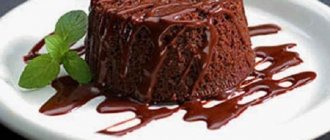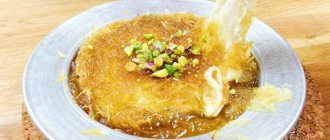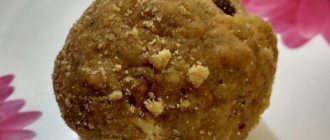Foreigners laugh: “They give you a salary in condensed milk? Why do you have it in every dessert?” Well, what can I say - in Russia they really love condensed milk. We also know how to cook delicious cakes from nothing and desserts like gingerbread or rolls, which are stored for months. We can boast of delicious jam from sour northern berries or aromatic southern fruits, dozens of varieties of honey, candied pine cones and a huge variety of pies. We'll tell you what desserts you should surprise foreigners in Russia with, what you should give to your foreign friends, and what sweets you should bring to visit them. Don’t be ashamed of your roots - no one jokes with us out of malice, and our pies and preserves are truly praised from the heart.
We wrote a separate article about dishes of national Russian cuisine that should be treated to foreigners. Be sure to check it out to get some ideas.
Syrniki
This Russian dessert surprises foreigners, but always delights them. Moreover, not all of them know well what cottage cheese is. In many countries it is not customary to drink desserts with tea. Therefore, cheesecakes can be recommended as an independent dish. Of course, with sour cream, condensed milk, berry jelly or jam. Definitely topped with powdered sugar. The homeland of syrniki is Ukraine, but the dish is also considered national in Russia and Belarus. Ruddy, juicy and so appetizing - you can’t do without additives.
Candied fruit
Initially, candied fruits were watermelon rinds boiled in water and honey syrup. During the cooking process, only the white part of the watermelon rinds was used. After the resulting “blanks” had dried, they were boiled again. To enhance the taste, lemon zest was added to the syrup. The finished dessert looked like a thick, translucent jam with a pronounced aroma.
Nowadays, candied fruits are fruits boiled in sugar syrup and dried in the oven. They are recommended by nutritionists as they are low in calories and contain many vitamins. Some of the most popular fruits used to make the modern version of candied fruits include pumpkin, tangerines, oranges, papaya and pineapples.
Gingerbread
Russian gingerbreads are not like European ones. Soft, crumbly, with a pleasant hard crust - many foreigners like them. If you are going abroad, bring Russian gingerbread to the locals. Not necessarily “Tula”. Any will do: classic with glaze, chocolate, mint, cranberry, honey, with jam or painted Arkhangelsk roe. You should try gingerbread with tea. Preferably from a samovar, but a regular one, of course, will also do.
Sweet pancakes
Many foreigners are sure that in Russia they eat pancakes exclusively with caviar. And not on holidays, but almost every day. Pancakes have become a symbol of Russian cuisine, caviar - hospitality. However, it is worth dispelling the stereotype and offering guests a dessert version of the national dish. Russian pancakes are especially good with the following additions:
- honey with berries;
- ghee with oatmeal;
- lingonberry jam (or any other);
- condensed milk;
- sweet cottage cheese.
Rolls and bagels
An excellent traditional treat for tea! Kalach is a soft, rich bread. An appetizing fresh bun with a golden brown crust or poppy seed topping. The kalach can also be grated, or in the form of a weight (a symbol of Murom and an excellent gift for foreigners) or a pretzel. The last option can be quite large. But in Russia, miniature dry “pretzels” have taken root more. They are baked with salt or poppy seeds. Bagels include bagels. And also, of course, Russian sushi: “shuttle”, “malyutka”, mustard, glazed, vanilla, with poppy seeds - for every taste.
MENU “TEA PARTY IN Rus'”
Kaluga dough
Valdai bagels
Lefties
Kaluga dough
The original recipe for this sweet was lost during the revolution. What is known for certain is that the delicacy was prepared from black crackers with the addition of honey, sugar caramel or sugar syrup.
Ingredients: Ground rye crackers - 2 cups, sugar syrup - 1 cup.
Recipe: Mix all ingredients, add spices - cinnamon, cloves, star anise, cardamom. Place the resulting mass in the refrigerator. In the cold, the jam-like mass can be stored for up to three months without spoiling.
Photo: Ekaterian Zaitseva
Valdai bagels
In “Journey from St. Petersburg to Moscow,” Alexander Radishchev wrote very emotionally about Valdai: “This town is memorable in terms of the love disposition of its inhabitants, and especially unmarried women. Who hasn’t been to Valdai, who doesn’t know Valdai bagels and Valdai flushed girls?”
Ingredients: eggs - 2 pcs., butter - 2 tsp., water - 1/2 cups, salt - 1/2 tsp. l., flour - 2 1/2 cups.
Recipe: Sift the flour, collect it in a mound, and make a well in the middle. Pour eggs into the hole, add soft butter, salt and carefully pour in water. Knead the stiff dough. Roll out the dough into ropes, cut them into several pieces and roll the bagels. Boil water in a saucepan, lower the bagels into it and cook, stirring, until they swell and float, about 5 minutes. Remove the bagels with a slotted spoon, place on a plate and let cool slightly. Sprinkle the bagels with poppy seeds or caraway seeds. Place the products on a baking sheet covered with oiled paper. Bake for 10-15 minutes at 230-250°C.
Moscow types. Bagel merchant Photo: wikimedia.org
Lefties
Lenten delicacy: crushed berries, dried in a heated oven in the form of flat cakes. They were also used as a cure for colds and vitamin deficiency. The aroma of summer berries in dry layers persisted for a long time. In Mikhailovskoye, where Pushkin’s maternal ancestors came from, the Hannibals were famous for their left-handed gonobobel (blueberry) crushes.
Ingredients: berries (any) - 1 kg, water - 1/3 cup, granulated sugar - 1/3 cup.
Recipe: You can take any berries (raspberries, strawberries, blueberries, black currants), you can even use frozen ones. Place the berries in a ceramic pot, add water (if the berries are frozen, you don’t need to add water). Simmer in the oven at 120°C until the berries are soft. Rub the softened berries through a sieve. Add sugar, put on low heat, cook until thick, stirring constantly. Place the mixture on a baking sheet covered with parchment in a layer 0.5 cm thick. Dry the lefties in the oven at 60°C until dry (about 6 hours). Finished lefties should not stick to your hands. Then roll them into a roll, wrap them in parchment and store them.
Paste
A healthy Russian dessert that is definitely worth giving to foreigners. Buy a box of “Belevskaya” or “Kolomenskaya” for them - this is a wonderful gift from Russia. The sweetness is completely natural. Most often, Russian pastila is prepared from sour apples with honey. There are also other types: lingonberry, rowan, raspberry, currant, cranberry. Honey is sometimes replaced with sugar. Previously, marshmallows were baked in a Russian oven or dried in the sun. They still do this in Belevo and Kolomna. However, it is worth treating foreigners with modern marshmallows. The sweetness is really interesting, unusual, special.
Baked apples
Due to the peculiarities of the climate, there are quite a lot of dishes with apples in Russian cuisine - these fruits easily tolerate temperature changes. Despite the fact that most varieties growing in Russia have a characteristic “sourness”, they make excellent desserts.
So domestic chefs came up with a way to make apples sweeter - they were soaked in sweet syrup, cored and filled with various fillings. An apple baked with nuts, honey or other filling is a healthy sweet that is rich in potassium and iron.
"Bird's milk"
Cake or candy – it doesn’t matter, both options are good. First, treat foreigners to this traditional Russian dessert, and then tell it its name. Surprised eyes are guaranteed. Many people really wonder if it’s because of this that the filling tastes so unusual. However, who among us did not think about the same thing as a child? Today, Bird's Milk candies are prepared throughout Russia. The box is traditionally decorated with an image of a bird. This makes it even more confusing for foreigners. In a word, an excellent hotel!
Smokva
This is an old recipe that is gradually returning to Russian usage. The so-called “dried apples of paradise”, or figs, are an analogue of marshmallow. Initially, dried figs were called this, but now the dessert is made from rowan, plum, quince or apples.
Sometimes this dish is called “dry jam”. Pre-revolutionary confectioners crushed dried berries and mixed them with honey, and then formed small candies. Fresh figs resembled “taffy candies,” and if you let them sit in a dry place, they became like caramel. Sometimes the finished dessert was additionally powdered with berry or sugar flour.
Another variation of figs is oven-baked fruit, pre-cut into slices and sprinkled with sugar.
And if you want to try real Russian sweets prepared according to ancient recipes, we suggest ordering them at Sladrus. Natural and original delicacies will amaze your imagination!
Cheesecake
Not even all modern schoolchildren know what a cheesecake is. What can we say about foreign citizens? Be sure to treat them to this traditional Russian dessert. These fluffy soft flatbreads with open filling will not leave anyone indifferent. Cheesecake with cottage cheese and raisins is considered a classic. However, baking with potatoes, jam or marmalade causes no less delight. Cheesecakes are good for warm tea, and if they are cold, for fruit drinks.
Sweet pies
Large open pies or neat “grandmother’s” pies with filling? All options are good. Pot-bellied buns with apple jam, northern shangi with oatmeal, Karelian wickets with wild berries, southern baskets with cherries, sochniki with cottage cheese, manniki, kulebyaki with lingonberries, pies with currants... You can name at least a hundred options. Feel free to treat foreigners to any Russian desserts. Pies have always been a symbol of hospitality. They are truly highly regarded. And while guests from abroad sometimes make fun of our salads, for example, they really admire our pies.
Cockurka plantains
Kokurka, kakurka or kakorka is a pie with an egg baked inside. It was prepared quickly and simply - sour cream or yogurt was added to the rye flour. Knead the dough and roll it out thinly. The eggs were boiled, peeled and pinched into this rich rye flatbread. 10 minutes in the oven - the dessert is ready.
People loved to take these pies with them on trips. They called them affectionately - plantain chickens, plantains, plantains. In the fairy tale “Girl Snow Maiden” by V.I. Dalia's grandfather rocks the Snow Maiden to sleep and sings: “Sleep, our Snow Maiden, sweet little girl…” In the fairy tale “Marya Morevna,” Ivan Tsarevich sets off on a journey to look for Koshchei with plantains baked by Marya Morevna.
We also find smokestacks in Gogol’s “Dead Souls”: “... in the remote streets and nooks of the city a very strange carriage rattled... It did not look like a tarantass, nor a carriage, nor a chaise, but rather looked like a thick-cheeked, convex watermelon... The watermelon was filled with chintz pillows, stuffed with sacks of bread, rolls, kokurki, skorodumki and pretzels made from choux pastry. Chicken pie and pickle pie even looked up... a lady got out of the carriage: this lady was a landowner, Korobochka’s collegiate secretary...”
Merchant and industrialist Ambrose Prokhorov.
Fudge
You probably shouldn't give fudge to every foreigner. But it’s probably worth treating close friends to it. You will watch the reaction with interest. Europeans and Americans are often surprised how Russian people eat such sweet desserts (they have never seen how they drank condensed milk from cans in the USSR!). Fudge is made from milk and molasses. It can be used as candy or as a frosting for other desserts. The most popular types of sweets:
- fruity;
- sugar;
- creamy with candied fruits and creme brulee;
- sherbet with nuts;
- iris.
Mazunya
Another forgotten Russian folk sweet is mazunya (or mazyunya). This unique delicacy was actively prepared in villages because of its simplicity, since it contained only molasses and radishes. Flour was prepared from the root vegetable - it was finely chopped, dried in the oven and crushed.
Molasses was made from spices, herbs and honey. After this, both ingredients were mixed, and the resulting mass was sent to the oven. The result was a thick, sweet mass, which was placed on bread or eaten with a spoon.
"Anthill"
Be sure to treat foreigners to the Anthill cake. Golden shortbread dough, deep-fried, delicate cream based on boiled condensed milk, crunchy nuts, grated chocolate... Of course, the cake was not invented out of a good life. And there is no benefit to it. But it literally melts in your mouth, and therefore is invariably a success. Similar cakes are popular in Austria, Slovenia, Germany, America, and Finland. Feel free to treat foreigners to our “Anthill” - the dessert always goes with a bang.
Of the other cakes, we can offer three more:
- Napoleon (in the Russian version - “Stepka-Rastrepka”).
- Count's ruins.
- Red Moscow.
And don't forget about chak-chak. Yes, it’s not exactly a cake, but foreigners still perceive it as such. Any of the desserts can be a great gift. If you are going to visit a foreigner, grab a Russian cake for tea - you won’t go wrong!
If you are going to another country or expecting guests, read the article with gift ideas from Russia. No earflaps or bears with balalaikas – only the best.
>>> Useful services for travelers <<










